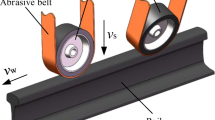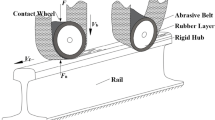Abstract
In order to calculate analytically the contact status for rail grinding by abrasive belt with an axis deflection, as well as considering limitations of using Hertz contact theory for that, a numerical contact model (NCM) based on the local geometrical relationship between contact wheel and rail surface was developed. The effectiveness and accuracy of the proposed model have been validated by the corresponding finite element model (FEM) by comparing the contact boundary and contact stress distribution. Comparative cases at two typical grinding positions with different attitudes were involved, and the effects of applying axis deflection on contact behavior were investigated in detail. The results from NCM and FEM both agreed belt grinding with an axis deflection was able to enlarge the contact width of the belt and the total grinding force under the premise of ensuring required width of grinding trace on the rail. The model provides insights into understanding contact behavior under actual working conditions and gives a theoretical basis for future researches based on contact analysis.

















Similar content being viewed by others
References
Liu YM, Yang TY, He Z, Li JY (2018) Analytical modeling of grinding process in rail profile correction considering grinding pattern. Arch Civ Mech Eng 18(2):669–678. https://doi.org/10.1016/j.acme.2017.10.009
Zhi SD, Li JY, Zarembski AM (2015) Grinding motor energy saving method based on material removal model in rail grinding processes. Int J Precis Eng Manuf-Green Technol 2(1):21–30. https://doi.org/10.1007/s40684-015-0003-1
Zhi SD, Li JY, Zarembski AM (2016) Predictive modeling of the rail grinding process using a distributed cutting grain approach. Proc Inst Mech Eng Part F-J Rail Rapid Transit 230(6):1540–1560. https://doi.org/10.1177/0954409715605139
Fan WG, Cheng JF, Lu HB, Li JY, Song XY (2018) Research on time-varying contact behavior and simulation for waved rail surface grinding by abrasive belt. J Mech Eng 54(4):87–92
He Z, Li JY, Liu YM, Nie M, Fan WG (2017) Investigating the effects of contact pressure on rail material abrasive belt grinding performance. Int J Adv Manuf Technol 93(1–4):779–786. https://doi.org/10.1007/s00170-017-0498-4
Xiao GJ, He Y, Huang Y, Li Q (2019) Shark-skin-inspired micro-riblets forming mechanism of TC17 titanium alloy with Belt grinding. IEEE Access 7(1):107636–107648. https://doi.org/10.1109/ACCESS.2019.2932725
Wang WX, Salvatore F, Rech J, Li JY (2018) Investigating adhesion wear on belt and its effects on dry belt finishing. J Braz Soc Mech Sci 40(12):570. https://doi.org/10.1007/s40430-018-1496-7
Xiao GJ, Huang Y (2015) Constant-load adaptive belt polishing of the weak-rigidity blisk blade. Int J Adv Manuf Technol 78(9–12):1473–1484. https://doi.org/10.1007/s00170-014-6724-4
Cheng C, Li JY, Liu YM, Nie M, Wang WX (2019) Deep convolutional neural network-based in-process tool condition monitoring in abrasive belt grinding. Comput Ind 106:1–13. https://doi.org/10.1016/j.compind.2018.12.002
Liu Z (2013) The design of rail milling train grinding equipment and the research of the grinding force control. Dissertation, Central South University
Rech J, Kermouche G, Grzesik W, García-Rosales C, Khellouki A, García-Navas V (2008) Characterization and modelling of the residual stresses induced by belt finishing on a AISI52100 hardened steel. J Mater Process Technol 1(1):567–570. https://doi.org/10.1016/j.jmatprotec.2007.12.133
Coste C, Falcon E, Fauve S (1997) Solitary waves in a chain of beads under Hertz contact. Phys Rev E 56(56):6104–6117. https://doi.org/10.1103/PhysRevE.56.6104
Wang W, Liu F, Liu ZH, Yun C (2017) Prediction of depth of cut for robotic belt grinding. Int J Adv Manuf Technol 91(1–4):699–708. https://doi.org/10.1007/s00170-016-9729-3
Wang YQ, Hou B, Wang FB, Ji ZC (2017) A controllable material removal strategy considering force-geometry model of belt grinding processes. Int J Adv Manuf Technol 93(1–4):241–251. https://doi.org/10.1007/s00170-016-8860-5
Xiao GJ, Huang Y (2017) Adaptive belt precision grinding for the weak rigidity deformation of blisk leading and trailing edge. Adv Mech Eng 9(10):1–12. https://doi.org/10.1177/1687814017731705
Pandiyan V, Caesarendra W, Tjahjowidodo T, Tan HH (2018) In-process tool condition monitoring in compliant abrasive belt grinding process using support vector machine and genetic algorithm. J Manuf Process 31:199–213. https://doi.org/10.1016/j.jmapro.2017.11.014
Zhang X, Kuhlenkötter B, Kneupner K (2005) An efficient method for solving the Signorini problem in the simulation of free-form surfaces produced by belt grinding. Int J Mach Tools Manuf 45(6):641–648. https://doi.org/10.1016/j.ijmachtools.2004.10.006
Ren X, Cabaravdic M, Zhang X, Kuhlenkötter B (2007) A local process model for simulation of robotic belt grinding. Int J Mach Tools Manuf 47(6):962–970. https://doi.org/10.1016/j.ijmachtools.2006.07.002
Ren X, Kuhlenkötter B, Müller H (2006) Simulation and verification of belt grinding with industrial robots. Int J Mach Tools Manuf 46(7):708–716. https://doi.org/10.1016/j.ijmachtools.2005.07.033
Wang YJ, Huang Y, Chen YX, Yang ZS (2016) Model of an abrasive belt grinding surface removal contour and its application. Int J Adv Manuf Technol 82(9–12):2113–2122. https://doi.org/10.1007/s00170-015-7484-5
Sun Y, Vu TT, Halil Z, Yeo SH (2017) Pressure distribution of serrated contact wheels—experimental and numerical analysis. Int J Adv Manuf Technol 90(9–12):3407–3419. https://doi.org/10.1007/s00170-016-9630-0
Wang WX, Li JY, Fan WG (2019) Investigation into static contact behavior in belt rail grinding using a concave contact wheel. Int J Adv Manuf Technol 101(9–12):2825–2835. https://doi.org/10.1007/s00170-018-3049-8
Zhang X, Kneupner K, Kuhlenkotter B (2006) A new force distribution calculation model for high-quality production processes. Int J Mach Tools Manuf 27(7–8):726–732. https://doi.org/10.1007/s00170-004-2229-x
He Z, Li JY, Liu YM, Yan JW (2019) Investigation on wear modes and mechanisms of abrasive belts in grinding of U71Mn steel. Int J Adv Manuf Technol 101(5–8):1821–1835. https://doi.org/10.1007/s00170-018-3029-z
Zhang XQ, Chen HB, Xu JJ, Song XF, Wang JW, Chen XQ (2018) A novel sound-based belt condition monitoring method for robotic grinding using optimally pruned extreme learning machine. J Mater Process Tech 260:9–19. https://doi.org/10.1016/j.jmatprotec.2018.05.013
Funding
This work was supported by the Fundamental Research Funds for the Central Universities [Grant Number 2018JBZ105].
Author information
Authors and Affiliations
Corresponding author
Additional information
Technical Editor: Lincoln Cardoso Brandao.
Publisher's Note
Springer Nature remains neutral with regard to jurisdictional claims in published maps and institutional affiliations.
Rights and permissions
About this article
Cite this article
Wang, W., Li, J., Fan, W. et al. A numerical model to investigate contact status for rail grinding by abrasive belt with an axial deflection. J Braz. Soc. Mech. Sci. Eng. 41, 494 (2019). https://doi.org/10.1007/s40430-019-2006-2
Received:
Accepted:
Published:
DOI: https://doi.org/10.1007/s40430-019-2006-2




